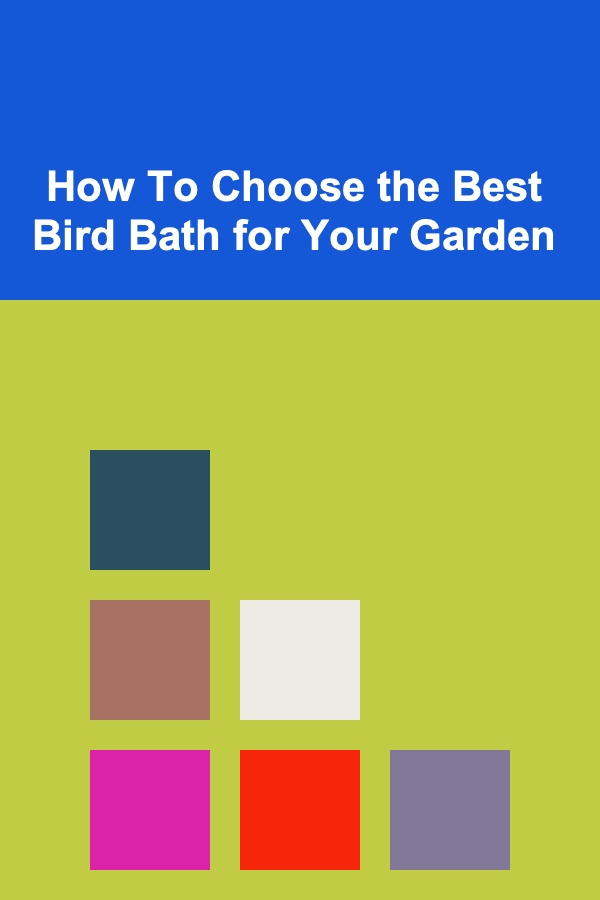
How To Choose the Best Bird Bath for Your Garden
ebook include PDF & Audio bundle (Micro Guide)
$12.99$8.99
Limited Time Offer! Order within the next:

Adding a bird bath to your garden is one of the best ways to attract wildlife, enhance your outdoor space, and create a peaceful retreat in your own backyard. Bird baths provide a source of water for birds, offering hydration and a place to bathe, which is essential for their health and wellbeing. Whether you are an avid birdwatcher or simply want to bring more nature into your garden, choosing the right bird bath is key to ensuring both the safety and enjoyment of your feathered friends.
In this comprehensive guide, we will explore the factors you should consider when choosing the best bird bath for your garden, the different types of bird baths available, and the maintenance required to keep them in top condition.
Why Bird Baths Are Important for Birds
Before diving into the details of how to choose the best bird bath, it's important to understand the significance of bird baths for birds. Birds need water for several reasons, including drinking, bathing, and cooling off during hot weather. A bird bath provides all of these benefits and can attract a wide variety of bird species to your garden.
Drinking Water
Birds require fresh water for hydration, especially during dry periods. While birds can often find water in puddles or ponds, a bird bath provides a reliable and clean source of drinking water. This is particularly important in urban and suburban areas, where natural water sources may be scarce.
Bathing and Grooming
Birds spend a significant amount of time preening and grooming their feathers to maintain their waterproofing and insulation. Bathing is an essential part of this grooming routine. A bird bath allows birds to bathe in a safe environment, which helps them maintain healthy plumage.
Cooling Off
On hot summer days, birds often need to cool off. A bird bath offers a refreshing way for birds to lower their body temperature. This is particularly important for birds living in regions with high temperatures.
Types of Bird Baths
Bird baths come in various shapes, sizes, materials, and designs, making it important to choose the right type that fits both your garden and the needs of the birds you want to attract. Here are the main types of bird baths you can choose from:
2.1. Freestanding Bird Baths
Freestanding bird baths are the most common and traditional type. They are typically mounted on a pedestal or post and sit above the ground. These bird baths are available in a variety of materials, including stone, concrete, metal, and ceramic. Freestanding bird baths are ideal for gardens with open space where they can be placed in a central location, making them easy for birds to spot.
Pros:
- Versatile and can be placed anywhere in the garden.
- Available in various designs, from classic to modern.
- Can hold a larger amount of water, making them suitable for multiple birds.
Cons:
- May be prone to tipping over in windy conditions.
- Require regular cleaning to prevent algae growth.
2.2. Hanging Bird Baths
Hanging bird baths are suspended from a hook or chain, and they are usually smaller in size than freestanding models. They are ideal for gardens with limited space or areas with low-growing plants. Hanging bird baths can be made from materials like glass, ceramic, or metal and are often more decorative than other types.
Pros:
- Ideal for smaller gardens or areas with limited space.
- Less likely to attract debris or dirt from the ground.
- Can be placed in trees, making them more natural for birds.
Cons:
- Smaller in size, so they may not hold as much water.
- Can be more difficult to clean due to their hanging nature.
2.3. Ground Bird Baths
Ground bird baths are placed directly on the ground, offering a more natural bathing experience for birds. These baths are typically made from materials such as stone, concrete, or clay and are often wide and shallow. Ground bird baths attract a wide variety of birds, especially those that prefer to bathe in natural settings, such as sparrows and robins.
Pros:
- Provides a more natural bathing environment for birds.
- Easier to clean and maintain than freestanding or hanging baths.
- Can attract a larger variety of bird species.
Cons:
- May be prone to debris, dirt, and leaves from the ground.
- Can be difficult to maintain in areas with heavy foot traffic or pets.
2.4. Solar-Powered Bird Baths
Solar-powered bird baths are equipped with a small solar pump that circulates water. These bird baths are ideal for gardeners who want to add a bit of movement and sound to their garden. The movement of water can attract more birds, and the gentle trickle of water provides a calming sound in your outdoor space.
Pros:
- Provides continuous water movement, which birds find attractive.
- Adds a relaxing sound to your garden.
- Often energy-efficient and eco-friendly.
Cons:
- May require direct sunlight to function properly.
- Can be more expensive than traditional bird baths.
2.5. Bird Bath Fountains
Bird bath fountains combine the benefits of a bird bath with the visual appeal of running water. These bird baths often have a fountain feature that circulates the water, attracting more birds while also adding a decorative element to your garden. Bird bath fountains can be powered by solar energy or electricity.
Pros:
- The movement of the water attracts more birds.
- Adds a decorative touch to your garden with the soothing sound of running water.
- Can be powered by solar energy or electricity.
Cons:
- More expensive than traditional bird baths.
- Requires more maintenance due to the pump system.
Factors to Consider When Choosing the Best Bird Bath
When choosing a bird bath for your garden, there are several important factors to consider. These include the material, size, depth, and design of the bath, as well as the overall aesthetic of your garden.
3.1. Material
The material of your bird bath is one of the most important considerations, as it impacts both the durability and appearance of the bath. Here are the most common materials used for bird baths:
- Concrete: Concrete bird baths are durable and can withstand the elements. They are available in a variety of designs and are often larger in size.
- Stone: Stone bird baths are natural and blend well into gardens with a rustic or natural look. They are also durable and long-lasting.
- Ceramic: Ceramic bird baths are often decorative and come in various colors and designs. However, they can be more fragile than other materials and may crack in cold weather.
- Metal: Metal bird baths, such as those made from copper or brass, are long-lasting and resistant to rust. They can add a sleek, modern touch to your garden.
- Plastic: Plastic bird baths are lightweight and easy to move, but they may not be as durable as other materials. They are often more affordable but may not have the aesthetic appeal of other options.
3.2. Size and Depth
The size and depth of the bird bath are important factors to consider, as they determine which bird species will be attracted to the bath. Smaller bird baths are ideal for small songbirds, while larger bird baths can accommodate a wider variety of birds. The depth of the bath is also crucial---too deep, and birds may have difficulty bathing; too shallow, and they may not be able to submerge fully.
A good rule of thumb is to choose a bird bath that is no deeper than 2 to 3 inches at the center. This ensures that birds can comfortably bathe and drink without the risk of drowning.
3.3. Location
The location of your bird bath is also important. It should be placed in a quiet area of your garden that is easily accessible to birds, but not too close to trees or bushes that could provide cover for predators. Ideally, the bird bath should be placed in a sunny spot so that the water remains clean and doesn't freeze in cold weather.
Consider placing your bird bath near a tree or shrub that provides shelter for birds but not so close that predators can hide. If you have a garden with a pond, consider positioning the bird bath near it to create a cohesive natural space.
3.4. Design and Aesthetics
The design of your bird bath should complement the overall aesthetic of your garden. Whether you prefer a classic, rustic look or a more modern, sleek design, there are bird baths to suit every style. Choose a design that fits your garden's vibe and adds to the visual appeal of the space.
3.5. Ease of Maintenance
Keeping your bird bath clean is essential to ensure it remains a safe and healthy water source for birds. Choose a bird bath that is easy to clean and maintain. Some bird baths have removable bowls or liners that make cleaning easier, while others have self-cleaning features like built-in drainage or fountains.
Consider the amount of time you are willing to invest in maintaining the bird bath. Ground bird baths, for example, may require more frequent cleaning, as they are closer to the ground and more likely to collect debris.
Maintenance Tips for Bird Baths
To keep your bird bath in top condition and ensure that it remains a safe and appealing environment for birds, regular maintenance is key. Here are some tips to keep your bird bath clean and functioning properly:
- Clean the bird bath regularly: Wash the bird bath with mild soap and water every week to prevent algae buildup and the growth of harmful bacteria. Use a soft brush to scrub away dirt and debris.
- Empty and refill the water: Change the water regularly, especially during hot weather, to ensure that it stays fresh and clean.
- Check for cracks or damage: Inspect your bird bath regularly for cracks or damage. Repair any damage immediately to prevent water from leaking and to ensure the safety of the birds.
- Remove debris: Clear any leaves, twigs, or dirt from the bird bath to keep it clean and safe for birds to use.
Conclusion
Choosing the best bird bath for your garden is a rewarding process that will enhance your outdoor space and provide a valuable resource for local wildlife. By considering factors such as material, size, depth, location, and design, you can select a bird bath that meets the needs of both you and the birds you wish to attract. Regular maintenance will ensure that your bird bath remains a safe and welcoming haven for birds throughout the year.

How to Create a Comfortable and Functional Living Space
Read More
How To Develop Your Emotional Intelligence
Read More
How to Recognize Signs of Deafness in Your Pet
Read More
Stop Blending In: How to Stand Out by Embracing Your Uniqueness
Read More
Holiday Season Feng Shui: Creating Joyful Gatherings
Read More
10 Tips for Thank You Cards for Housewarming Gifts
Read MoreOther Products

How to Create a Comfortable and Functional Living Space
Read More
How To Develop Your Emotional Intelligence
Read More
How to Recognize Signs of Deafness in Your Pet
Read More
Stop Blending In: How to Stand Out by Embracing Your Uniqueness
Read More
Holiday Season Feng Shui: Creating Joyful Gatherings
Read More